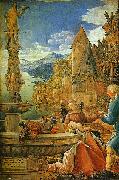Wholesale Oil Painting No Minimum |
|||||||||||
|
|
|||||||||||

|
|||||||||||
|
|
|
||||||||
Philipp Otto RungeGerman Romantic Painter, 1777-1810 ..German painter, draughtsman and theorist. He stands alongside Caspar David Friedrich as a leading figure in German Romantic painting even though his early death restricted his oeuvre to relatively few stages of development. The enduring prominence of philosophical and theoretical concerns suggests that further work would have contributed to the history of ideas as well as to that of art. Runge's greatest influence was on later, largely 20th-century artists and thinkers rather than on his immediate contemporaries. While 19th-century developments certainly bore out Runge's claim for a new, symbolic role for landscape, |
||||||||
|
|
||||||||
Ruhe auf der Flucht
Ruhe auf der Flucht Painting ID:: 71891 |
1805-1806
Oil on canvas
98 x 132 cm
1805-1806 Oil on canvas 98 x 132 cm |
|||||||
|
|
||||||||
Hans RottenhammerGerman Painter, ca.1564-1626 |
||||||||
|
|
||||||||
|
|
Ruhe auf der Flucht
Ruhe auf der Flucht Painting ID:: 74240 |
Deutsch: Ruhe auf der Flucht
Date Deutsch: 1. Viertel 17. Jh.
English: 1st quarter of 17th century
Medium Oil on canvas
Current location Deutsch: Gemäldegalerie
Deutsch: Kassel
cyf Deutsch: Ruhe auf der Flucht Date Deutsch: 1. Viertel 17. Jh. English: 1st quarter of 17th century Medium Oil on canvas Current location Deutsch: Gemäldegalerie Deutsch: Kassel cyf |
||||||
|
|
||||||||
Albrecht AltdorferGerman 1480-1538 Albrecht Altdorfer Galleries He most often painted religious scenes, but is mainly famous as the first frequent painter of pure landscape, and also compositions dominated by their landscape. Taking and developing the landscape style of Lucas Cranach the Elder, he shows the hilly landscape of the Danube valley with thick forests of drooping and crumbling firs and larches hung with moss, and often dramatic colouring from a rising or setting sun. His Landscape with footbridge (National Gallery, London) of 1518-20 is claimed to be the first pure landscape in oil. He also made many fine finished drawings, mostly landscapes, in pen and watercolour. His best religious scenes are intense, sometimes verging on the expressionistic, and often depict moments of intimacy between Christ and his mother, or others. His most famous religious artwork is the The Legend of St. Sebastian and the Passion of Christ that decorated the altar in the St. Florian monastery in Linz, Austria. He often distorts perspective to subtle effect. His donor figures are often painted completely out of scale with the main scene, as in paintings of the previous centuries. He also painted some portraits; overall his painted oeuvre was not large. |
||||||||
|
|
||||||||
|
|
Ruhe auf der Flucht
Ruhe auf der Flucht Painting ID:: 83015 |
1510(1510)
Medium Oil on wood
Dimensions 58,2 x 39,2 cm
cyf 1510(1510) Medium Oil on wood Dimensions 58,2 x 39,2 cm cyf |
||||||
|
|
||||||||
|
Albrecht Altdorfer German 1480-1538 Albrecht Altdorfer Galleries He most often painted religious scenes, but is mainly famous as the first frequent painter of pure landscape, and also compositions dominated by their landscape. Taking and developing the landscape style of Lucas Cranach the Elder, he shows the hilly landscape of the Danube valley with thick forests of drooping and crumbling firs and larches hung with moss, and often dramatic colouring from a rising or setting sun. His Landscape with footbridge (National Gallery, London) of 1518-20 is claimed to be the first pure landscape in oil. He also made many fine finished drawings, mostly landscapes, in pen and watercolour. His best religious scenes are intense, sometimes verging on the expressionistic, and often depict moments of intimacy between Christ and his mother, or others. His most famous religious artwork is the The Legend of St. Sebastian and the Passion of Christ that decorated the altar in the St. Florian monastery in Linz, Austria. He often distorts perspective to subtle effect. His donor figures are often painted completely out of scale with the main scene, as in paintings of the previous centuries. He also painted some portraits; overall his painted oeuvre was not large. Ruhe auf der Flucht 1510(1510) Medium Oil on wood Dimensions 58,2 x 39,2 cm cyf |
||||||||
|
|
||||||||
|
Prev Next
|
||||||||
|
|
||||||||
|
Related Paintings to Albrecht Altdorfer :. |
||||||||
|
|
||||||||
|
CONTACT US |



